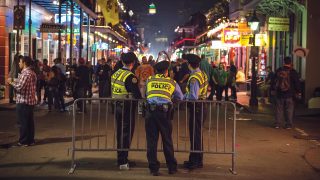
“Our first responders are uniquely strong, brave, and emotionally flexible. They are called upon to support us on the worst days of our lives. They hear and see things that are burned into their memories forever. They see the worst of humanity, and then they go home and do their best to be a loving partner, parent, and friend.” — Shauna H. Springer, Ph.D., The Human Toll of Trauma for Law Enforcement Officers, May 4, 2022
Much has been said and written lately regarding what many, including myself, believe to be a burgeoning crisis in law enforcement. We are talking about the rise of law-enforcement-related suicides, mental health issues, ongoing physical and emotional trauma, burnout and the seemingly divergent and controversial belief that law enforcement “gangs” have somehow seized control of various agencies, including the Los Angeles County Sheriff’s Department (LASD). Let’s take a look at what experts in the field of police psychology have to say about some of these issues.
Shauna “Doc” H. Springer, Ph.D., is a well-known and highly regarded leading authority on trauma, close relationships, suicide prevention and initiatives that impact the military and veteran community. Springer’s work has been featured on NPR, NBC, CBS News Radio, Forbes, Psychology Today and Military Times. In short, she knows what she’s talking about. Here are just a few of her observations regarding the untold human toll of a career in law enforcement:
- Nationwide, the risk of suicide among police officers is 54% greater than among American workers in general.
- More officers die by suicide each year than are killed in the line of duty.
- Nearly a quarter of officers have witnessed a fellow officer being killed or injured in the line of duty.
- Nearly a third have been exposed to a badly beaten child or have been personally and seriously injured in the line of duty.
- About 40% have been trapped in a life-threatening situation or have had to make a death notification.
- Over half have been threatened with a gun or knife.
- Nearly all have seen someone die.
These are all mind-numbing statistics, to be sure.
Another professional in the field of law enforcement trauma is Ana Gamez, Ph.D., MBA, who has studied the topic for more than two decades. She is currently the chief executive officer of Badge of Life, a 501(c)(3) law enforcement support organization (badgeoflife.org).
Both Springer and Gamez have noted the abundance of evidence validating the phenomenon of trauma bonding in both law enforcement and the military.
Regarding the phenomenon of trauma bonding, Gamez writes:
“Trauma bonding in law enforcement emerges from the unique high-pressure experiences officers encounter in the line of duty. The nature of police work, marked by shared trauma, isolation, and coping mechanisms — creates an environment that makes it possible for officers to form deep emotional connections with other officers who have experienced similar traumas.
“Police officers routinely face high-stakes situations such as violent crime scenes, life-threatening encounters, and exposure to human suffering. These intense, often dangerous experiences create a cluster of shared experiences between officers, similar to those developed in the military. These emotional bonds result from connections repeatedly established in a highly stressful environment.”
In her follow-up article, “The Mental Health Crisis Within Law Enforcement” (May 19, 2025), Gamez discusses the concept of Trauma, Ideology, Coercion, Ego (T.I.C.E), a mental health framework for first responders that she developed after years of experience in the law enforcement environment.
Gamez explains that this model helps clarify the psychological shifts that occur in first responders who are repeatedly exposed to high-stress and life-threatening situations. She notes that individuals outside of law enforcement or military service typically experience two to four significant traumatic events in their lifetime, whereas law enforcement officers may experience such trauma three to four times per month!
Gamez goes on to note: “Similar to military men and women who are deployed and return home with post-traumatic stress disorder (PTSD), and who only choose to share their feelings and thoughts with other military personnel, law enforcement officers also establish powerful bonds with one another. These bonds are developed in many cases because the officer feels that only another fellow officer understands their pain. Thus, nobody else, including their spouses, understands what they are going through. These powerful connections are in many ways the body and brain’s response to trauma exposure. Thus, what some people may interpret as ‘cliques’ or ‘subcultures’ are often the only support systems these officers have.”
“What some people may interpret as ‘cliques’ or ‘subcultures’ are often the only support systems these officers have.”
Now that we have a solid framework for understanding the concept of trauma bonding in law enforcement, let’s get to the meat of the argument against the thought that gangs have somehow run wild in the LASD.
Gamez succinctly notes her concerns regarding California Penal Code Sections 13670–13675 (anti-peace officer gang laws):
“This legislation criminalizes perceived ‘subgroups’ within law enforcement by broadly labeling them as ‘gangs’ based on shared identifiers such as tattoos, group names, or mutual loyalty. Such sweeping mischaracterization undermines officers’ mental wellness by penalizing the very camaraderie and coping mechanisms essential for managing the cumulative trauma experienced throughout their careers.
“These coping mechanisms emerged in the military after exposure to trauma. Criminalizing these internal support structures ignores the fundamental truth that a gang member’s ideology differs from that of a law enforcement officer. A gang member operates under a self-serving ideology, often driven by power, criminal enterprise, violence, and rebellion against societal order. Whereas, a law enforcement officer operates under an oath-bound ideology rooted in service, sacrifice, duty, and life protection, even at their own cost.”
Gamez concludes: “Criminalizing trauma-bonded officer units under anti-gang laws does a great injustice to those who serve. Rather than labeling these subgroups as threats, we must understand them through the T.I.C.E. lens and build structured wellness programs that reflect the unique trauma burden of law enforcement professionals.”
These two professional, highly respected doctors have identified what those of us in law enforcement have known all along: there is good reason to doubt the notion that an organized gang culture thrives within the LASD.
Officers frequently face life-or-death situations, critical incidents and emotionally taxing events, such as shootings, accidents or domestic violence cases. These shared experiences foster a sense of camaraderie and mutual reliance, as officers depend on one another for both physical and emotional safety.
Have some people done dumb things on the job? Sure. Have some of those dumb things been done by people with station tattoos? Sure. But just as surely, if you show me someone with a tattoo who did something stupid, I can show you just as many who did something equally dumb without one. Conversely, I’m sure that personnel with station tattoos have also performed acts of extreme bravery and selflessness in service to the community, often at the expense of their own well-being.
In this case, the truth may very well be an inconvenience to those who continue to shout the “deputy gang” mantra. Some want to keep the faux controversy alive because it generates social media “clicks” or offers a sense of “validation” for their beliefs. Others simply don’t like law enforcement and point to the issue as proof that all cops are corrupt.
It is my understanding that not a single member of the LASD has ever been found to have violated department policy regarding the anti-gang issue, nor have any been charged, tried or convicted of violating state laws related to it. There’s a reason for that: both the policy and state law are built on the false premise that deputies have established gangs within the department. On the contrary, it appears that a number of our deputies have been so deeply affected by continuous trauma that they have developed trauma bonds with fellow deputies who have experienced the same.
Let’s face it, folks, the average person on the street will never know, let alone understand, what cops put up with on a daily basis. They cannot possibly fathom the inhumanity that other humans can subject their fellow man to. After all, they don’t need to — it’s one of the things cops take care of so they don’t have to.
As seen in the November 2025 issue of American Police Beat magazine.
Don’t miss out on another issue today! Click below:





